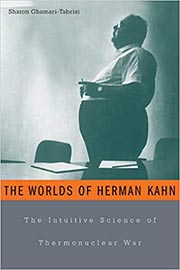The Worlds of Herman Kahn: The Intuitive Science of Thermonuclear War
by Sharon Ghamari-Tabrizi
Reviewed December 18, 2005
 Herman Kahn is an enigma in the world of nuclear strategy. His sensational ideas, embodied in his On Thermonuclear War (1960), dared to explore the concept of not only fighting a nuclear war but surviving one. Sharon Ghamari-Tabrizi delves into the remarkable and terrifying world of Herman Kahn, offering a unique portrait of the analyst who gleefully articulated a vision of a survivable post-nuclear war world. The Worlds of Herman Kahn, as the title implies, is not a biography of Kahn, but rather a description of the world he inhabited, and how the media, Kahn, the U.S. government and various aspects of American culture in the 1950s and 60s, came together on the subject of nuclear war. One of the best examples is the fact that he was the model for Stanley Kubrick's Dr. Strangelove.
Herman Kahn is an enigma in the world of nuclear strategy. His sensational ideas, embodied in his On Thermonuclear War (1960), dared to explore the concept of not only fighting a nuclear war but surviving one. Sharon Ghamari-Tabrizi delves into the remarkable and terrifying world of Herman Kahn, offering a unique portrait of the analyst who gleefully articulated a vision of a survivable post-nuclear war world. The Worlds of Herman Kahn, as the title implies, is not a biography of Kahn, but rather a description of the world he inhabited, and how the media, Kahn, the U.S. government and various aspects of American culture in the 1950s and 60s, came together on the subject of nuclear war. One of the best examples is the fact that he was the model for Stanley Kubrick's Dr. Strangelove.
Ms. Ghamari-Tabrizi provides a fascinating look at a very complex man. Kahn was born in Bayonne, New Jersey, in 1922, grew up in the Bronx, NY and, after his parents divorced, in Los Angeles. He went to U.C.L.A. and majored in physics, then entered a Ph.D. program at Cal Tech. He failed to graduate-family financial problems interfered-and finally went to work at RAND Corporation (an U.S. Air Force funded think tank). While there he became involved in the development of the hydrogen bomb and eventually its strategic use. Kahn left RAND and founded his own think tank, the Hudson Institute. There he continued thinking about the unthinkable, as well as exploring new topics such as the issue of Vietnam and futurology. Kahn died of a massive stroke in 1983.
The book carefully avoids passing judgment on his ideas. Instead, Ghamari-Tabrizi paints us a picture of the man behind these ideas and the times in which he lived. This book is an excellent examination of a world of "unknown unknowns" that still exists around us today.